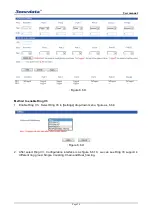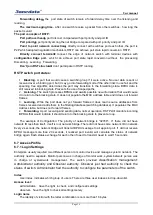
User manual
Page 45
Port mirroring refers to copy data from the port which need to be monitored to appointed monitoring
port for analysis and monitoring. Ethernet switch supports many-for-one mirror which means messages
from several ports can be copied to a monitored port. User can appoint the direction of monitored
message, such as only monitoring of transmitted messages of appointed port. The device configures
port mirroring function through port mirroring group. Each group includes a monitored port and a group
of mirror ports. Total bandwidth of mirroring is not more than that of monitored port. It is good to monitor
and manage its internal network data when using port mirroring in a company. It is also good to locate
the failure when network is cut up.
Example as figure : Port 3 collect all of the data from port 1 and port 2
Mirror Port
It defines a group of ports which are needed to be monitored. The device collects data from these
ports.
Monitored Port
It defines a group of ports which are used to monitor other ports. The device outputs the data
through these ports.
Watch direction
This parameter indicates the direction of the data. It includes 3 kinds of choices: "All", "Ingress" and
"Egress".
1. This function is not often used. Otherwise other port-based higher management function like RSTP,IGMP
SNOOPING
2. Port mirroring function can only deal with the normal FCS packets. It cannot deal with error data frames.
6.11Basic settings
6.11.1 Device address
Device configuration support two modes, DHCP and static IP address, can get the device’s IP
address via client when the DHCP function is running, if you need NTP that need to connect internet,
please enter the available and correct gateway and DNS address.
IP Address
IP address is a address of 32 bits length which is assigned to the device on the internet. The IP
address consists of two fields: the network number field (net-id) and the Host ID field (host-id). For can
conveniently manage IP address, IP addresses are divided into five categories. As blow
:










































